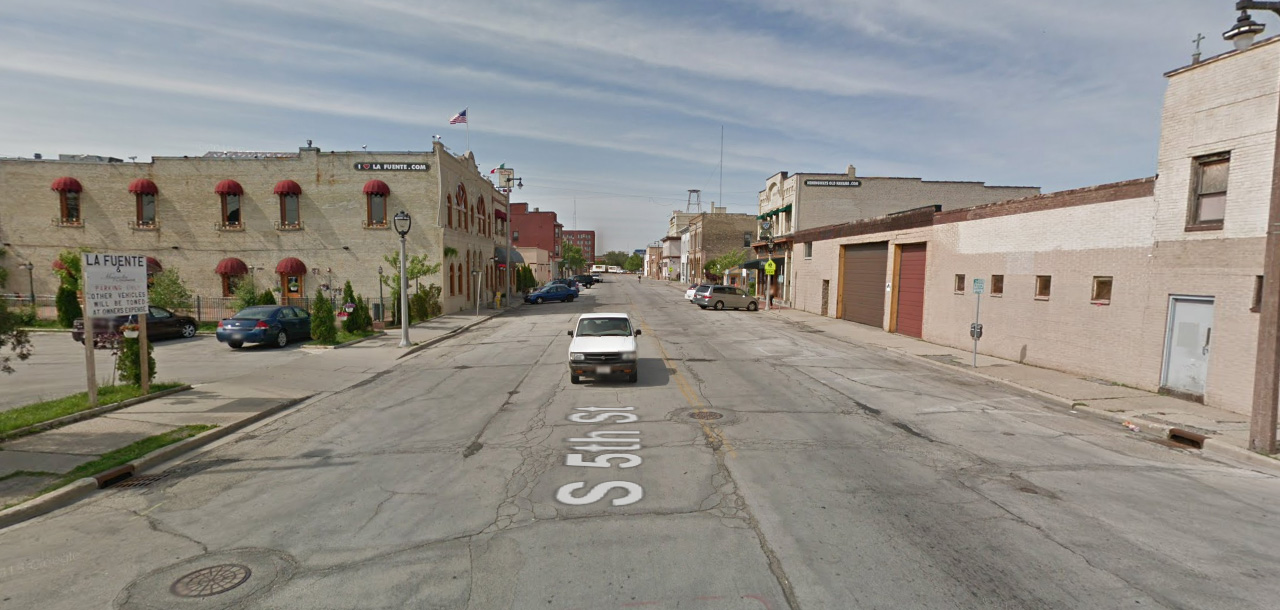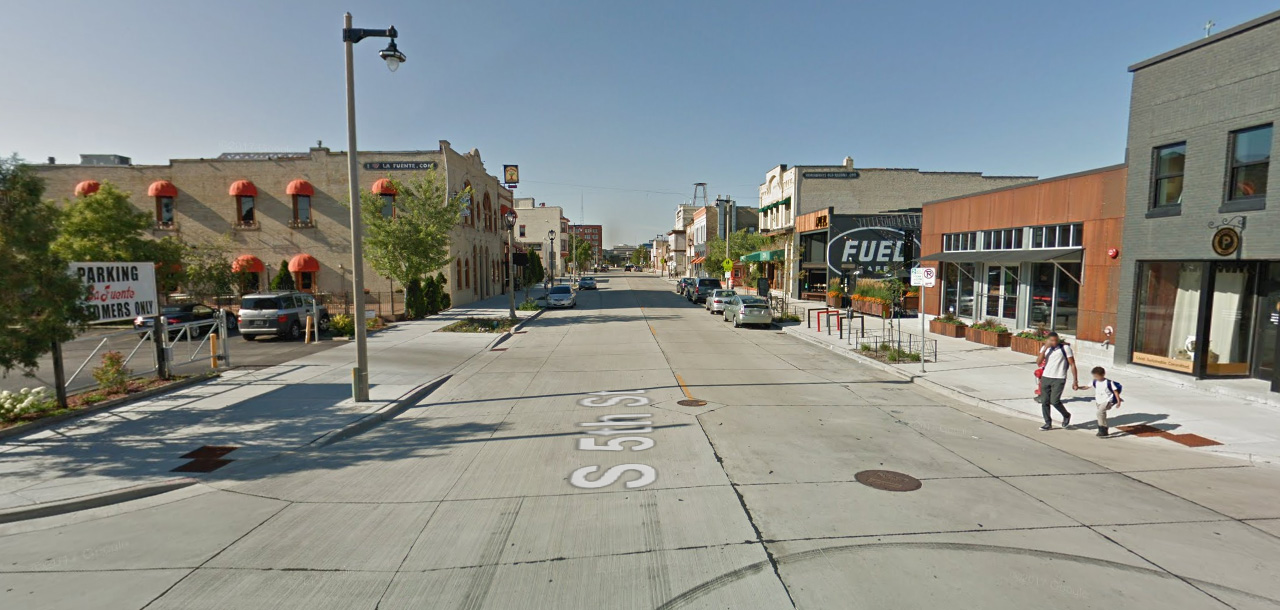City a Leader in Complete Streets Policy
Milwaukee's Complete Streets policy ranks third nationally in report, but yet to be tested.


On paper, the city’s recently adopted Complete Streets policy, designed to ensure the safety of all road users, is a clear winner.
An analysis by Smart Growth America of the 66 Complete Streets policies passed in 2018 found Milwaukee’s policy the third strongest.
Milwaukee’s policy was signed into law by Mayor Tom Barrett in October. “People want safe and vibrant streets. People want choices… Too often our streets are difficult to cross and have speeding vehicles,” said the mayor while standing in front of a group of community advocates on the recently redesigned S. 5th St.
“Milwaukee’s policy earned 80 [out of 100] points—it’s a solid policy with all of the basics. Although there is room for improvement, the policy is notable for emphasizing streets that reflect their surrounding context and creating a strong committee responsible for implementation that is made up of both city staff and people from outside organizations,” reads the report.
The scoring framework used by Smart Growth America shows that Milwaukee’s policy scores high for its vision and intent, respect of diverse users, clear exceptions, performance measures and jurisdiction.
The latter was predictable given the city’s decision to eschew prescriptive design rules for complete streets in favor of general guidance on which users to prioritize: “Above all, safety is imperative, with pedestrian safety having the highest priority followed by the next most vulnerable types of users,” the city policy declares. (By contrast, the old state policy on complete streets, created under Democratic Gov. Jim Doyle, was more prescriptive, but was repealed by his successor, Gov. Scott Walker.)
Smart Growth’s scoring rubric for implementation references design standards, so the lack of prescriptive design standards could have lowered the city’s score.
The city, which formed a committee of city department heads and committee chairs to oversee the policy’s implementation, may thus rely more heavily on political will to implement changes to its streets.
This fact isn’t lost on members of the Common Council. Ald. Nik Kovac warned that the fight over safer streets isn’t over when the proposal was debated by the council’s Public Works Committee. “Sometimes we’re going to have to make a tough decision where we’re going to have to lose some productivity or travel time. That’s a fight we should be prepared to win,” said the Riverwest and East Side alderman.
One of those key decision makers will be Zoning & Neighborhood Development Committee chair Ald. Khalif Rainey. The alderman’s office sent out an alert yesterday about a Department of Public Works-led walk of N. 35th St. near the Century City redevelopment site focused on identifying potential traffic safety improvements.
Ald. Michael Murphy expressed concern about DPW design engineers in his comments in support of the ordinance. The attitude of some, he once suggested, is “I have a traffic manual handbook that was printed by God. I have to follow that handbook because it’s what’s in the handbook.”
Bauman echoed such concerns: “For the 15 years I’ve been on the council I’ve always been pushing this stuff and there has always been pushback. I certainly support this (Complete Streets policy) and hopefully it has some impact.”
The city likely lost points on its score by not including an explicit reference to the use of the Federal Highway Administration‘s Manual of Uniform Traffic Control Devices. The policy of the city of Madison, Connecticut was singled out as a strong example for its inclusion of the manual as one of two “definitive design guides” on street design.
Milwaukee’s policy doesn’t mandate the redesign of every street immediately, but instead impacts any public works project on city streets.
A recent Milwaukee Police Department report indicates there is a steadily growing need to redesign many of the city’s most problematic intersections.
Crashes involving motor vehicles in the city are up 51 percent from 2009 to 2018. Of the top 10 intersections for crashes, five of them involve W. Capitol Dr. The top two intersections are W. Capitol Dr. and N. Sherman Blvd. and W. Capitol Dr. and N. 35th St.
City officials will also have decisions to make with long-term projects.
Conceptual plans for the extension of The Hop streetcar system to Bronzeville along N. Martin Luther King Jr. Dr. depict the four-lane street reduced to one travel lane in each direction, but will officials have the political courage to do so? Lane removals, which included the addition of new bike lanes, for The Hop’s first phase on N. Broadway and N. Milwaukee St. were ultimately abandoned.
According to Smart Growth’s National Complete Streets Coalition, a total of 1,477 communities across the nation have passed policies to date.
If you think stories like this are important, become a member of Urban Milwaukee and help support real independent journalism. Plus you get some cool added benefits, all detailed here.
Legislation Link - Urban Milwaukee members see direct links to legislation mentioned in this article. Join today
Political Contributions Tracker
Displaying political contributions between people mentioned in this story. Learn more.
City Hall
-
Council Blocked In Fight To Oversee Top City Officials
 Dec 16th, 2025 by Jeramey Jannene
Dec 16th, 2025 by Jeramey Jannene
-
Latest Effort to Adopt New Milwaukee Flag Going Nowhere
 Dec 3rd, 2025 by Jeramey Jannene
Dec 3rd, 2025 by Jeramey Jannene
-
After Deadly May Fire, Milwaukee Adds New Safety Requirements
 Dec 2nd, 2025 by Jeramey Jannene
Dec 2nd, 2025 by Jeramey Jannene
Transportation
-
Congestion Pricing Cuts Air Pollution in New York City
 Dec 14th, 2025 by Jeff Wood
Dec 14th, 2025 by Jeff Wood
-
FTA Tells Milwaukee to Crack Down on Fare Evasion — Even Where Fares Don’t Exist
 Dec 12th, 2025 by Graham Kilmer
Dec 12th, 2025 by Graham Kilmer
-
Will GOGO’s Bus Service Ever Get Going?
 Dec 9th, 2025 by Jeramey Jannene
Dec 9th, 2025 by Jeramey Jannene




















